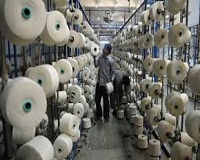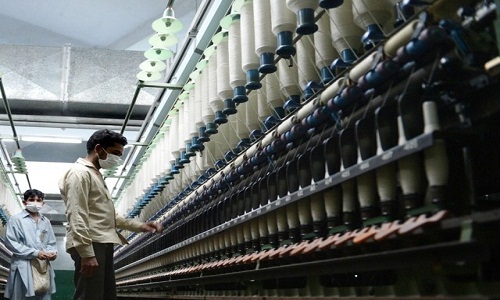FW
Pure London, the largest fashion festival, being held in London from July 22-24, 2018 will feature an edited collection of over 700 global brands, including some of the best emerging designers showcasing their latest collections in the UK for the first time; sustainable and ethical collections in Pure Conscious; and childrenswear in Pure Kid.
Sourcing and manufacturing show Pure Origin has grown this season and now includes a dedicated Denim area and a future Fabric Trends display.
The show will include exclusive SS19 future trend insights by WGSN and catwalk shows, including Graduate Fashion Week winners and childrenswear. It will also feature a host of worshops and provide networking opportunities including keynote addresses from Maya Jama, Professor Caryn Franklin, and Hilary Alexander OBE discussing diversity, ethics and sustainability in fashion.
Pure London, will also collaborate with Scoop to offer buyers a complimentary taxi service between the two shows.
Khazanah Nasional Berhad, the strategic investment fund of the Malaysian government, is planning to invest in the Indian arm of Pepe Jeans.
Khazanah joins The Carlyle Group, Advent International and General Atlantic to acquire a stake in Pepe Jeans. The three US-based private equity funds were shortlisted to acquire a controlling stake in the Indian arm of Pepe Jeans.
The valuation is still being negotiated between Khazanah and Pepe. Earlier, the branded apparel group was seeking a valuation of Rs 2,000 crore ( $US .29 billion) for its business in India. Pepe Jeans India is a wholly-owned subsidiary of Pepe Jeans Group headquartered in Barcelona, Spain. The company was originally founded by three Indians, Arun, Nitin and Milan Shah, in London in 1973 as a weekend stall denim brand.
Pepe Jeans in India has over 215 franchise stores and retails its branded apparel through 1,000 multi-brand stores in the country. For fiscal year 2017, the firm posted net of Rs 49 crore ($US 7.12 million) and sales of Rs 424 crore ($US 0.62 billion), according to filings with Registrar of Companies.
The Karachi Cotton Association has urged the government to waive all duties and taxes on import of cotton immediately in the national interest so that the local textile industry is able to export optimum quantity of value added products of raw cotton in the international market.
The Pakistan government had decided to impose 3 percent customs duty, 2 percent additional customs duty, 5 percent sales tax and 1 percent income tax on import of raw cotton with a view to encourage use of the local cotton crop.
KCA views that the Government should realise that due to anticipated decline in cotton production again in cotton season 2018-19 especially owing to severe water shortage during cultivation period and usual factors of reduction in yield per acre, cultivation of sugarcane in the areas earmarked for cotton cultivation and supply of uncertified Cotton Seed etc.
The local textile industry is, therefore, compelled to import raw cotton from abroad to meet its requirement of basic/primary raw material.
However, after payment of such heavy duties and taxes imposed on import of cotton, the cost of imported cotton will be considerably increased due to which the local textile industry will become unable to compete in the international markets. As a result of this, the exports of value added products of cotton and foreign exchange earning of the country will be badly affected.
The GST Council has decided to refund accumulated credit on account of inverted duty structure to fabric manufacturers.
CITI has applauded the decision. CITI has been consistently requesting the government to give relief to the fabric segment as for the overall growth of the textile sector, fabric sector plays an important role and it also generates a sizeable employment opportunities of 40 jobs on each 1 crore investment - which is more than any segment of the textile value chain. Hence, decision to allow refund of accumulated Input Tax Credit (ITC) at Fabric stage due to inverted duty structure is a big relief to the textile sector.
The rates cut on Chenille fabrics and other fabrics under heading 5801 and Handloom dari to 5 per cent from 12 per cent is a big win for the textile manufacturers who were reeling under immense pressure.
It would further boost employment in the powerloom sector, as about 40,000 textile workers have lost their jobs in last one year and would prevent further job losses.
EPCH has regularly been representing to the GST council for the smooth transition of exporters into the new taxation regime and for the reduction in the GST rates.
The 28th meeting of the GST council proposed reduction of GST rates on various items. The demands of the handicraft sector have also been considered and rates have been recommended to be reduced on many handicraft items. This rate reduction will help further result in rationalisation of the GST rates.
This initiative would certainly help over 11,000 member exporters and over 1 million craftspersons in enhancing production capacity, employability and achieve exports growth in the future.
IndustriALL Global Union affiliates, FENOTHAC and FESYNEME, who met in Cotonou as part of a programme by IndustriALL to build union strength in the country, agreed that the right to strike must be defended in all sectors, and that the unions should campaign against the government’s intention to ban the right to strike in oil and gas and electricity, which it says are essential services.
Further, workers' participation in union activities should be increased, national council formed, joint activities carried out, and communications improved.
The garment and textile sector has been in decline with most former factory workers now employed in the informal sector, where more than 90 per cent of the workers in Benin make out a living. So, most of the FENOTHAC members are in the small-scale traditional tailoring sector. On the other hand, mining is picking up and exports for gems and precious stones have begun.
"A recent report suggests ‘Made in US’ clothing is gaining ground with the government’s thrust and companies’ near-shoring strategies. The focus is on high-quality US craftsmanship priced competitively with imports. This proposition makes perfect sense for manufacturers and sellers as the entire supply chain is in their hands rather than depending on the external factors. These increasingly growing state of affairs is giving rise to ‘grown and sewn in the US’ phenomenon, where e-commerce lets small firms tell a story and sell directly to consumers who have an interest in natural fibres such as cotton and wool, a willingness to invest in longer-lasting higher-quality goods and a desire to shop local."
 A recent report suggests ‘Made in US’ clothing is gaining ground with the government’s thrust and companies’ near-shoring strategies. The focus is on high-quality US craftsmanship priced competitively with imports. This proposition makes perfect sense for manufacturers and sellers as the entire supply chain is in their hands rather than depending on the external factors. These increasingly growing state of affairs is giving rise to ‘grown and sewn in the US’ phenomenon, where e-commerce lets small firms tell a story and sell directly to consumers who have an interest in natural fibres such as cotton and wool, a willingness to invest in longer-lasting higher-quality goods and a desire to shop local.
A recent report suggests ‘Made in US’ clothing is gaining ground with the government’s thrust and companies’ near-shoring strategies. The focus is on high-quality US craftsmanship priced competitively with imports. This proposition makes perfect sense for manufacturers and sellers as the entire supply chain is in their hands rather than depending on the external factors. These increasingly growing state of affairs is giving rise to ‘grown and sewn in the US’ phenomenon, where e-commerce lets small firms tell a story and sell directly to consumers who have an interest in natural fibres such as cotton and wool, a willingness to invest in longer-lasting higher-quality goods and a desire to shop local.
Numerous start-ups are flourishing from this idea. For instance, McIntosh, founder of Homegrown Cotton, wasn’t satisfied with the imported polo shirts costing from $80 to $90. Thanks to changing paradigms, every step of the process is done in North and South Carolina. The shirt’s final cutting and sewing happens 40 miles from his farm. Similarly, Anna Brakefield and Mark Yeager, father-daughter owners of Alabama-based Red Land Cotton, started their bedding and towel brand a ‘farm-to-home’ product. By growing and ginning their own cotton, they create a higher-quality fibre, which is spun, woven and finished in South Carolina and Georgia before being sewn in their hometown. Earlier they were unable to find sewers who could do some of the finer detail hemming for their sheets, later found a small-scale sewing firm in their hometown to finish the sheets.
Quest for organic cotton
A growing perception is that people in the US are increasingly opting for US made clothing. A survey by Cotton Incorporated showed 66 per cent consumers say they are interested in buying US-made clothing made with US-grown cotton. Rob McMillian, Founder of Chicago-based Dearborn Denim, says when he started the company in 2016, he wanted to create an all-American apparel company that produced high-quality products at an affordable price to show that locally made goods don’t have to be more expensive. Even though the manufacturing costs are higher in Chicago than using foreign products and labour, the e-commerce route helped keep costs down. His women’s and men’s jeans cost around $60, competitive with prices of jeans from The Gap and Levi’s.
consumers say they are interested in buying US-made clothing made with US-grown cotton. Rob McMillian, Founder of Chicago-based Dearborn Denim, says when he started the company in 2016, he wanted to create an all-American apparel company that produced high-quality products at an affordable price to show that locally made goods don’t have to be more expensive. Even though the manufacturing costs are higher in Chicago than using foreign products and labour, the e-commerce route helped keep costs down. His women’s and men’s jeans cost around $60, competitive with prices of jeans from The Gap and Levi’s.
Tom Chappell, Founder of Ramblers Way, offers organic wool and cotton clothing online and does custom-made clothes in their shops in Maine and New Hampshire, said it took a lot of trial and error to get the fabric quality he wanted and to do it sustainably. They built their own factory in Canton, Mass., to create a superfine worsted Rambouillet merino and organic merino wool that wasn’t itchy and could be worn year-round.
"The Pakistan textile industry is facing tough times. Textile funds over Rs 200 billion ($US 1.56 billion), in the form of export rebate, sales tax refunds, etc, are stuck with the government. This is compelling industry to buy electricity and gas at an expensive rate compared to other countries in the region. Even water has to be procured through the tanker mafia. Despite all these hurdles, Pakistan’s exports have marked increase this year; the credit goes solely to exporters. Last year the government had announced a package of Rs 180 billion($US 1.40 billion) out of this, only Rs 25-30 billion($US 0.19-0.20 billion) was released. The earlier governments did not consider releasing the stuck up money. If released, this may bring more dollars through higher exports."
 The Pakistan textile industry is facing tough times. Textile funds over Rs 200 billion ($US 1.56 billion), in the form of export rebate, sales tax refunds, etc, are stuck with the government. This is compelling industry to buy electricity and gas at an expensive rate compared to other countries in the region. Even water has to be procured through the tanker mafia. Despite all these hurdles, Pakistan’s exports have marked increase this year; the credit goes solely to exporters.
The Pakistan textile industry is facing tough times. Textile funds over Rs 200 billion ($US 1.56 billion), in the form of export rebate, sales tax refunds, etc, are stuck with the government. This is compelling industry to buy electricity and gas at an expensive rate compared to other countries in the region. Even water has to be procured through the tanker mafia. Despite all these hurdles, Pakistan’s exports have marked increase this year; the credit goes solely to exporters.
Erroneous policies
Last year the government had announced a package of Rs 180 billion($US 1.40 billion) out of this, only Rs 25-30 billion($US 0.19-0.20 billion) was released. The earlier governments did not consider releasing the stuck up money. If released, this may bring more dollars through higher exports.
The decision of the finance ministry to devalue the local currency further hurt profits of local exporters and 20 per cent depreciation in rupee made import of raw material more expensive. Exporters say, devaluation of the local currency by the government encourages foreign buyers to demand a share of this devaluation leaving nothing for exporters.
of raw material more expensive. Exporters say, devaluation of the local currency by the government encourages foreign buyers to demand a share of this devaluation leaving nothing for exporters.
Profits on rupee depreciation
Despite the furore from the textile industry, analyst Shanker Talreja of Topline Securities observes profitability of textile sector increased 10 per cent in the current fiscal, while financial cost of companies declared in the quarterly result was 30 per cent. Major profit of textile companies occurred from the depreciation of the Pak rupee.
Declining investments
With potential investors hesitant to make new investments due to rising business costs, Pakistan’s textile industry has experienced decreasing investments over the last decade. Due to this, the sector has missed out on many technological advantages to competitors.
New investments dropped to more than half a billion rupees($US 390 million) in 2016-17, compared to Rs 1 billion($US 780 million) in 2005-06. Further, about 35 per cent of the textile industry’s production capacity was damaged, causing loss of approximately $4.14 billion worth of potential exports.
According to Pakistan Bureau of Statistics, while textile sector performed poorly, the exports of readymade garments registered a 13 percent year-on-year growth in July-May 2017-18, which stood at $2.346 billion in 2017-18
Corrective measures proposed
APTMA members proposed a long list of corrective and conducive policy measures to the government in return for their investments, including implementation of long-term policies, like consistent nationwide energy prices, removal of Rs 3.50 (3 cents) per kilowatt-hour surcharge on electricity tariff, an extension of the duty drawback scheme for five years and drawbacks to be increased every year by 1 percent for garments (up to 12 percent) and made-ups (up to 10 percent) against realisation of export proceeds.
The proposal also recommends long-term financing facility (LTFF) to indirect exports, Islamic financing and building of infrastructure for garment plants, a decrease in the electricity tariff in line with regional players, timely release of pending refunds, continuation of the drawback duties and reduction/elimination of the customs duties on import of synthetic yarn and Polyester Staple Fiber (PSF). It remains to be seen how many of these are actually implemented.
The American cotton industry seems to be plagued with many difficulties such as the age-old fumigation rules on import of US commodity in Bangladesh. These rules not only impose an additional cost burden on importers and spinners in Bangladesh but also results in increased lead time.
Apart from this, the US cotton industry leaders also noted phytosanitary requirement as a major hurdle for the import of cotton in the country. In addition, they also identified the distance between the two countries and the congestion at the Chittagong port as major hurdles for increasing US cotton shipment in Bangladesh.
China recently imposed 25 per cent retaliatory duty on the import of cotton from the US as part of the 'trade war' between the two countries. Reflecting on this, the US cotton industry insiders said that the move might result in slight changes in the trade flow of cotton across the world.
Premiere Vision New York was held from July 17 to 18. The trade show presented a comprehensive array of seminars, services and displays amid the European-centric, but globally represented fabric exhibitors. There’s a paradox that exists for the industry now: the US economy is strong, but the administration has caused chaos with the imposition of tariffs that have been countered by China, the European Union and Canada, and the threat of more.
The fashion industry in the US is struggling. This includes retailers trying to shift their business models in accordance with the e-commerce boom and changing consumer priorities, but also fighting with travel, electronics, home and entertainment for consumer dollars.
The show focused on delivering a more comprehensive presentation. It has taken to technology by creating an app that can be downloaded to guide visitors around the show, as they would be at an art museum. More trend presentations and talks were also introduced, along with smart talk seminars and displays.
Moving ahead with new technologies and the evolution of the trade show, Premiere Vision will launch a new digital online marketplace—starting with weavers—at Première Vision Paris in September. It will contain a catalog of resources and materials in the sector to augment the hands-on trade show experience.











